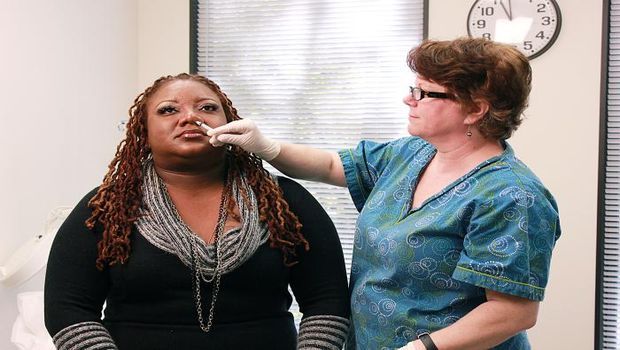Flu Nasal Spray Provides Similar Protection Against Influenza as Flu Shot
A study led by McMaster University researchers has found that, contrary to recent reports, flu nasal sprays provide similar protection against influenza as standard flu shots.


This image depicts a qualified nurse in a clinical setting, who was in the process of administering a dosage of FluMist® live attenuated intranasal vaccine LAIV) into the right nostril, and into this patient’s nasal cavity. Courtesy of the CDC
A study led by McMaster University researchers has found that, contrary to recent reports, flu nasal sprays provide similar protection against influenza as standard flu shots.
Published today in the scientific journal Annals of Internal Medicine, the study shows that the nose spray had a similar effect to the standard flu shot. Previous recommendations from the Centers for Disease Control’s Advisory Committee on Immunization Practices (ACIP) had previously called for nasal sprays, or live attenuated influenza vaccine (LAIV), not be used during the 2016-2017 flu season.
Dr. Mark Loeb, lead author of the study, says his team’s findings challenge the ACIP’s recommendations towards flu shots, or inactivated vaccines.
“Our study is the first blinded randomized controlled trial to compare the direct and indirect effect of the live vaccine versus the inactivated vaccine,” said Loeb, a professor in McMaster’s Department of Pathology and Molecular Medicine. “Our results are important because in previous years the live vaccine had first been preferred for children. In fact, as late as June 2014, the live vaccine was preferred. Then, subsequently, it was no longer preferred and now not recommended at all. Our trial showed no difference between the two in protecting entire communities.”
For the study, Loeb’s team conducted a three-year trial in a Hutterite colony, where people live communally and are relatively isolated from cities and towns, to determine whether vaccinating children and adolescents with the flu nasal spray provided better direct and community protection than the standard flu shot.
The researchers randomly assigned 1,186 children in 52 Hutterite colonies in Alberta and Saskatchewan, Canada to receive either the nasal spray vaccine or the flu shot and also followed 3,425 community members who did not receive a flu vaccine. Average vaccine coverage among children in the nasal spray group was 76.9 percent versus 72.3 percent in the flu shot group.
The original intention of the study was to show that nasal spray vaccines would provide better protection than flu shots, but Loeb says the conclusions of the study are now especially important, given the ACIP’s recommendations.
“The ACIP’s decision was an unprecedented decision in influenza vaccine policy-making for children. Our study challenges previous studies because our results show conclusively that the vaccines show similar protection when both direct and indirect effects are taken into account.”
Loeb says his team will continue to study herd immunity with different vaccine formulations by vaccinating children. They are also looking at the effect of repeated vaccination of children.
This study was funded by the Canadian Institutes for Health Research.
Source: McMaster University
Reflecting on the US Withdrawal from the World Health Organization
January 21st 2025An infection preventionist reels from the US exit from WHO, writing that it disrupts global health efforts, weakens infection control, and lacks research funding and support for low-income nations dependent on WHO for health care resources.
Infections Do Not Recognize International Borders: The Potential Impact of US Withdrawal From WHO
January 21st 2025The US withdrawal from WHO jeopardizes infection prevention, research funding, and global collaboration, disproportionately impacting low-income nations reliant on WHO support for equitable health care advancements.
Infection Intel:EvaClean Expands Global Reach With Microsplitting Partnership
January 20th 2025EvaClean partners with Microsplitting Ltd. to distribute its advanced disinfection systems and absorbents, revolutionizing infection prevention across health care, education, hospitality, and industrial sectors worldwide.